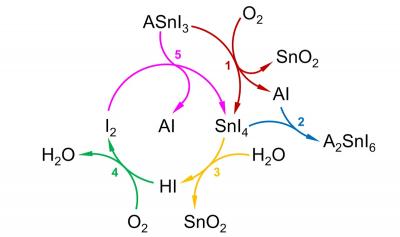Researchers at Imperial college London and the University of Bath have found the mechanism that causes perovskite-based solar cells to break down, and suggested a potential solution.

Versions of perovskite solar cells that use tin instead of lead tend to degrade quickly. Now, the researchers at Imperial and the University of Bath have shown how these perovskites degrade to tin iodide, which, when exposed to moisture and oxygen, forms iodine. This iodine then helps form more tin iodide, causing cyclic degradation.
Lead researcher Professor Saif Haque, from the Department of Chemistry at Imperial, said: "Knowing the mechanism will help us overcome a major stumbling block for this exciting new technology. Our results will also enable the design of tin perovskite materials with improved stability, paving the way for cheaper, more flexible solar harvesting devices."

